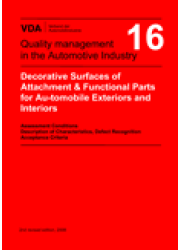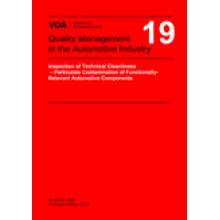VDA 16 Decorative surfaces of external fittings and functional parts in the internal and externals of automobiles
Quantity:
-
Add to Compare
Volume 16 Decorative surfaces of external fittings and functional parts in the internal and
externals of automobiles/ 2nd edition 2008
This VDA volume is intended to serve as an initial basis for bilateral negotiations between OEM and supplier, as well as between customer and supplier throughout the entire supply chain when agreeing a specification for the subjective characteristics of decorative surfaces. The results of such negotiations must then be recorded in individual contracts. It also serves to provide a clear and unambiguous description of decorative product surfaces (so-called “subjective surfaces”) and to specify uniform test & inspection conditions, in order to prevent process problems for customers and suppliers because of imprecise or incomplete means of measurement.
For those involved in production processes this VDA volume serves as a training aid, to ensure that processes are applied in accordance with agreed references.
Contents
|
1 |
Objective / purpose |
|
2 |
Area of application |
|
3 |
Validity |
|
4 |
Evaluation zones |
|
5 |
Evaluation conditions |
|
5.1 |
Position |
|
5.2 |
Lighting conditions |
|
5.2.1 |
Brightness and colour temperature (exterior/interior) |
|
5.2.2 |
Lighting angle |
|
5.2.3 |
Orientation of the light source |
|
5.3 |
Observation distance |
|
5.4 |
Observation period |
|
5.5 |
Target agreements |
|
5.5.1 |
ppm and degree of validity |
|
5.5.2. |
Quality position |
|
5.5.3 |
Determining the quality position |
|
5.5.4 |
Special ppm agreements |
|
5.6 |
Ensuring the comparability of inspectors and inspection requirements – aligniing the evaluation standard |
|
5.7 |
Handling samples from a process at maximum tolerance limits (MTP samples) and limit samples |
|
6 |
Defining characteristics / addressing defects |
|
7 |
Acceptance criteria |
|
7.1 |
Acceptable characteristics |
|
7.2 |
Quantifiable characteristics |
|
7.2.1 |
Classification |
|
7.2.2 |
Permitted density / frequency |
|
8 |
Evaluation method |
|
9 |
Miscellaneous |
|
10 |
Appendix data |
|
10.1 |
Table showing examples of acceptable characteristics |
|
10.2 |
Table showing examples of quantifiable characteristics, based on Table 10.1 |
|
10.2.1 |
Example of classification by size and permitted frequency |
|
10.2.2 |
Example of classification by minimum distance between individual defects |
|
10.3 |
Table showing examples of practice-related observation periods |
|
10.4 |
Example of a ppm calculation, taking account of items which slip through |
|
10.5 |
Pictures to aid discussion of characteristics |
|
10.6 |
Attributive gauge R & R effectiveness |
|
11 |
Bibliography |
Write a review
Your Name:Your Review: Note: HTML is not translated!
Rating: Bad Good
Enter the code in the box below:
Copyright © 2014 Engineering Standards Bureau. All Rights Reserved.
Developed By Zoom Into Web





